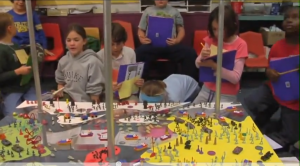Gamification is a tricky subject to quantify. As a conceptual region within the modern mind-map its just about brand new, yet games and play have probably been around since the dawn of man. Even a simple question at the heart of gamification–how long have people been using play mechanics to make things fun?–is more difficult to answer than one might expect. Work songs, anyone? Counting coup? One thing that does seem clear is that the idea of gamification–using principles found within games and consciously applying them to activities normally outside the gaming sphere–seems to very recent. At least until one stumbles upon the work of Buckminster Fuller.
 Buckminster Fuller, born in 1895, was the quintessential “renaissance man”. His most famous design projects include the geodesic dome (buckyballs are named in his honor), and the Dymaxion (an abbreviation of “Dynamic Maximum Tension”) design principle from which he derived a car, housing and cartographic model. He was a systems designer, a futurist and a visionary.
Buckminster Fuller, born in 1895, was the quintessential “renaissance man”. His most famous design projects include the geodesic dome (buckyballs are named in his honor), and the Dymaxion (an abbreviation of “Dynamic Maximum Tension”) design principle from which he derived a car, housing and cartographic model. He was a systems designer, a futurist and a visionary.
What is less well known is his tenure as a game designer and gamification evangelist. Fuller was trying to gamify nothing less than world peace and the complete streamlining of global resource allocation. In Fuller’s own words, “Make the world work, for 100% of humanity, in the shortest possible time, through spontaneous cooperation, without ecological offense or the disadvantage of anyone.”
The World Game, as imagined by Buckminster Fuller was a collaborative process in which players came together to propose solutions to large scale world problems within a specific time frame. The team that could demonstrate a solution using known technologies and available resources would ‘win’ the first round. Subsequent rounds would be won by teams that could improve upon earlier solutions.
In a Plowboy Interview, Fuller explains his take on the power of gamification and the World Game:
FULLER: You can see what a beautiful series of changes was created. And it wasn’t the school system—the educational process—that did it. It was simply this new environmental phenomena [of the radio]. A good voice, diction, authority and information coming into your home.
PLOWBOY: You believe that the World Game can be such an environmental phenomena? That more new information can create another series of changes?
FULLER: Yes, that’s my point. That new life was coming into the home directly, making the parents and local authorities obsolete. And that is exactly what’s happening in today’s generation. You are finding all the old schemes very inadequate. When the television came, the children could then see the new ways, and see and hear the changes.
PLOWBOY: The World Game, then, wants to condition people in a more informative, more useful way`?
FULLER: Every way. I’ve been concerned with changing the environmental factors, because that is what makes people act spontaneously in a preferred way. [emphasis mine].

Today the World Game continues to be played across Universities and is currently being developed by O.S. Earth. The World Game also has several spiritual relatives, the most notable chronicled in the documentary, World Peace and Other Fourth Grade Achievements, accepted at SXSW 2010. John Hunter carries the torch lit by Buckminster Fuller and spoke at this year’s TED on the power of games to build world peace. Perhaps the goal is no longer just child’s play.







